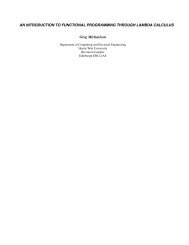Contents
Contents
Contents
You also want an ePaper? Increase the reach of your titles
YUMPU automatically turns print PDFs into web optimized ePapers that Google loves.
AMATH 581 ( c○J. N. Kutz) 13We begin by exploring accuracy. In the context of time-stepping schemes,the natural place to begin is with Taylor expansions. Thus we consider theexpansiony(t +∆t) =y(t)+∆t · dy(t) + ∆t2dt 2 · d2 y(c)dt 2 (1.2.1)where c ∈ [t, t +∆t]. Since we are considering dbfy/dt = f(t, y), the aboveformula reduces to the Euler iteration schemey n+1 = y n +∆t · f(t n , y n )+O(∆t 2 ) . (1.2.2)It is clear from this that the truncation error is O(∆t 2 ). Specifically, the truncationerror is given by ∆t 2 /2 · d 2 y(c)/dt 2 .Of importance is how this truncation error contributes to the overallerrorin the numerical solution. Two types of error are important to identify: localand global error. Each is significant in its own right. However, in practice weare only concerned with the global (cumulative) error. The global discretizationerror is given byE k = y(t k ) − y k (1.2.3)where y(t k )istheexactsolutionandy k is the numerical solution. The localdiscretization error is given byɛ k+1 = y(t k+1 ) − (y(t k )+∆t · φ) (1.2.4)where y(t k+1 )istheexactsolutionandy(t k )+∆t·φ is a one-step approximationover the time interval t ∈ [t n ,t n+1 ].For the Euler method, we can calculate both the local and global error.Given a time-step ∆t and a specified time interval t ∈ [a, b], we have after Ksteps that ∆t · K = b − a. Thuswefindlocal: ɛ k = ∆t22global:K∑ ∆t 2E k =2j=1= ∆t22d 2 y(c k )dt 2 ∼ O(∆t 2 ) (1.2.5a)d 2 y(c)dt 2d 2 y(c j )dt 2≈ ∆t22d 2 y(c)dt 2· K· b − a = b − a∆t 2 ∆t · d2 y(c)dt 2 ∼ O(∆t) (1.2.5b)which gives a local error for the Euler scheme which is O(∆t 2 )andaglobalerror which is O(∆t). Thus the cumulative error is large for the Euler scheme,i.e. it is not very accurate.Asimilarprocedurecanbecarriedoutforalltheschemesdiscussed thusfar, including the multi-step Adams schemes. Table 1 illustrates various schemesand their associated local and global errors. The error analysis suggests that theerror will always decrease in some power of ∆t. Thusitistemptingtoconcludethat higher accuracy is easily achieved by taking smaller time steps ∆t. Thiswould be true if not for round-off error in the computer.
















